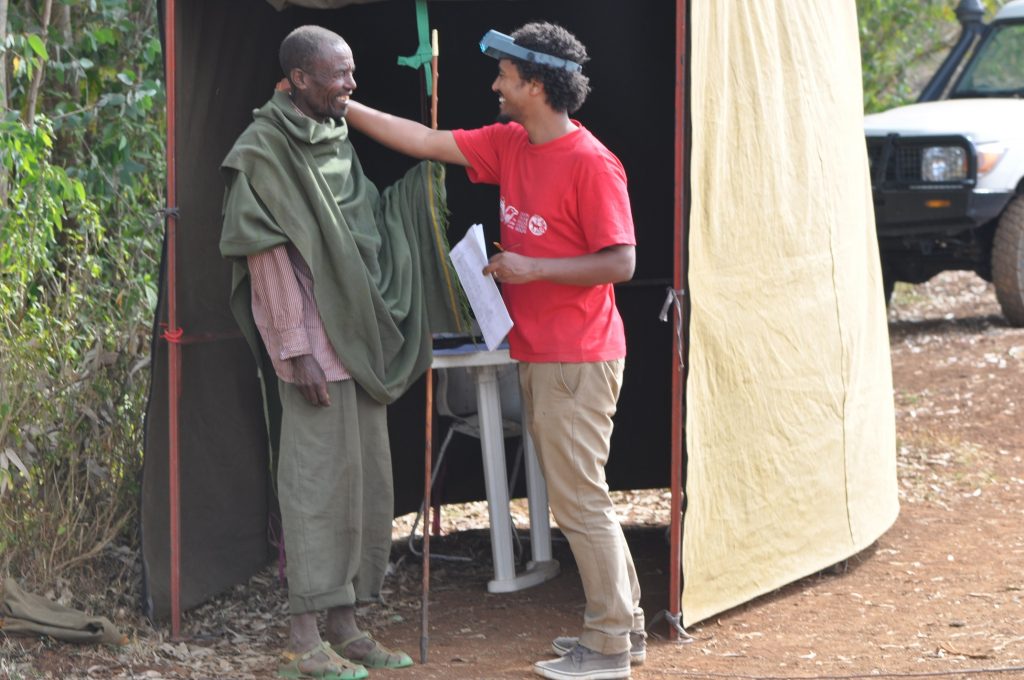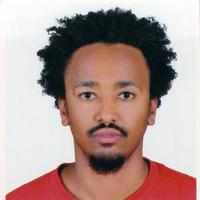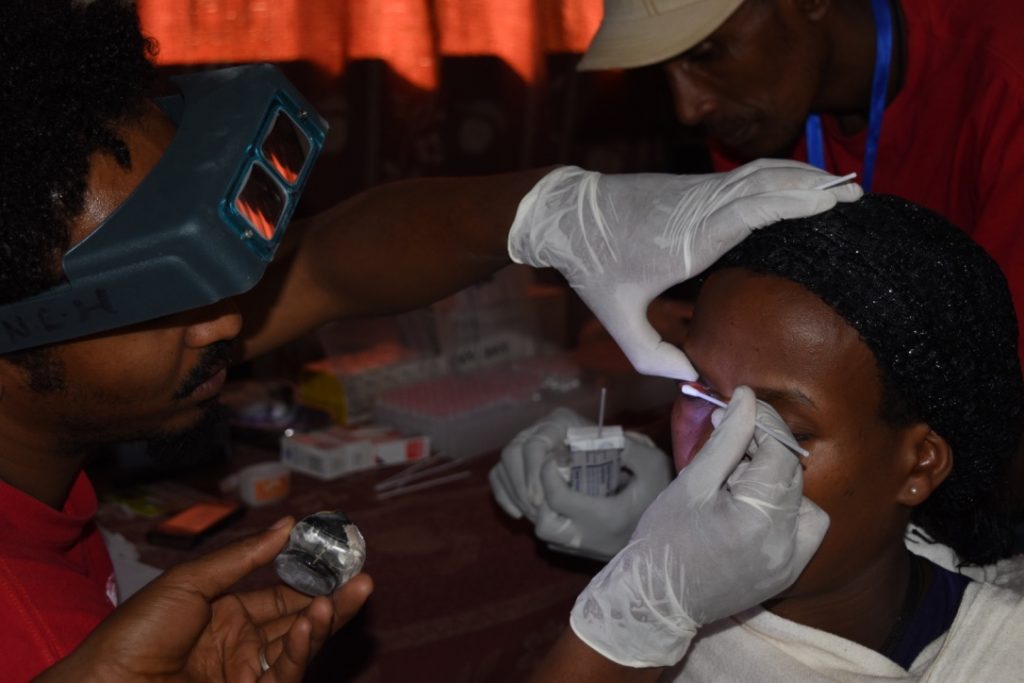 Esmael Habtamu Ali with patient during Trachoma field work in Ethiopia
Esmael Habtamu Ali with patient during Trachoma field work in Ethiopia
Register for the Eliminating Trachoma course here: https://www.futurelearn.com/courses/eliminating-trachoma/
Esmael Habtamu Ali PhD, Co-Lead Educator
My country, Ethiopia, has amongst the highest levels of avoidable blindness in the world. Cataract, corneal opacities from trachoma and refractive error are the leading causes of blindness.1 Trachoma is one of the most common Neglected tropical Diseases, and the leading infectious cause of blindness worldwide affecting the poorest of the poor.2,3 It is prevalent in developing and marginalised communities, particularly in Africa, where crowded living conditions are common and access to clean water, sanitation and health care are often limited.4-6
The blindness in trachoma is the result of the painful trachomatous trichiasis (eye lashes scratching the surface of the eye) due to enrolling of the eyelids (entropion) caused by conjunctival scarring provoked by the chronic inflammation and infection from the bacteria Chlamydia trachomatis. Trachomatous Trichiasis (TT) causes considerable pain leading to functional and physical impairment, social withdrawal and exclusion, and inability to work and earn an income even prior to the development of visual impairment.7,8
Trachoma can be easily prevented and treated. The WHO Alliance for the Global Elimination of Blinding Trachoma by 2020 (GET2020) recommends the SAFE Strategy to control trachoma.9 This involves Surgery to avert the risk of blindness from trachomatous trichiasis, together with Antibiotics (azithromycin or tetracycline), Facial cleanliness and Environmental improvements to suppress chlamydial infection and transmission. However, despite the extensive global effort trachoma is still a public health problem in 42 countries.2
Currently, about 200 million people live in trachoma endemic areas.2 Approximately 3.2 million people have un-treated TT and are at significant risk of sight loss, and 2.4 million people are visually impaired from trachoma of whom 1.2 million are irreversibly blind.2 Africa is the most affected continent from trachoma. About 18.3 million cases with infection and 2.24 million TT cases are found in Africa.10 This accounts for 85.3% and 70.9% of the active trachoma infection and TT cases worldwide. Three African countries (Ethiopia, Malawi and Nigeria) account for 50% of the trachoma at risk population worldwide. Four African countries (Ethiopia, Nigeria, Egypt and Uganda) account for more than 43% of the global TT surgical backlog.2
Ethiopia carries the largest burden of trachoma worldwide. About 75 million people are at risk of infection, more than 138,000 are irreversibly blind, and another 700,000 are at immediate risk of painful irreversible blindness from trachoma.2 Perhaps more than any other country in the world, in Ethiopia, enormous amount of effort is required to eliminate blinding trachoma. The millions of people who are at risk of blindness from trachoma need immediate surgery to correct the TT. It is this unnecessary suffering of communities inspired me to join the global task force to eliminating trachoma as a public health problem.
Professional Background
I completed the undergraduate ophthalmic officer course with Great Distinction at the University of Gondar in 2007. Between 2007 and 2010, successfully coordinated large collaborative research project on the management of the blinding stage of trachoma. In 2011 I won scholarship for MSc in Community Eye Health at LSHTM, UK and won the Gordon Johnson Prize for outstanding performance. I used this chance to grasp the appropriate skill and knowledge that I require to run effective eye care research projects and programmes in Ethiopia. After completing the MSc course at the LSHTM, I was involved in a project documenting “best Practices” in Zithromax Mass Drug Administration (MDA) (a drug distributed to control the pool of trachoma infection in communities). I visited six different trachoma control programmes in Ethiopia, Nigeria and Kenya and wrote case studies on Zithromax MDA from which best practices have been extracted and compiled in to a manual to guide trachoma control programmes.11
In In 2017 I completed my PhD on the surgical management of trachomatous trichiasis and it’s impact on quality of life. I was awarded the 2017 LSHTM Woodruff Medal for the outstanding doctoral thesis completed that year. In my PhD project, we provided community based surgical management to more than 2500 people suffering from the blinding stage of trachoma, in Ethiopia. We trained more than 400 community members from the health development army to screen, identify and refer trachoma cases that need surgical management. In this project, we compared two commonly used surgical procedures in randomised controlled trial (bilamellar tarsal rotation (BLTR) and posterior lamellar tarsal rotation (PLTR). We found that the PLTR is superior to the BLTR with lower rate of recurrence and complications.12 The results led to a shift in policy and currently WHO recommends that new surgical trainees in programs should be trained in the PLTR procedure.13
The Final Push to Eliminate Trachoma
The WHO led Global Alliance for the Elimination of Trachoma by 2020 (GET2020) is a couple of years away. Given the huge backlog, Ethiopia should make extra efforts to achieve this goal. For instance, with regard to averting the risk of blindness, in Ethiopia, we are facing two different challenge: There are still communities losing their eyesight from severe trachomatous trichiasis as they do not have access to surgical services; while on the other hand there are communities with access to surgical services but hesitant to utilise the service in relation to awareness and the quality of service being provided. We have previously demonstrated that training and deploying community members for the identification, counselling and referral of TT cases in their community could be the most productive approach to increase uptake of TT surgery. Much more need to be done on the F and E components of the SAFE strategy to break trachoma infection transmission through enhanced community involvement and ownership.
Building Capacities
The free online course, Eliminating Trachoma, is designed to build the capacities of district and community level trachoma control program implementers and mangers around the world involved in a fight to eliminate trachoma as a public health problem. It will help to identify the challenges that we are facing in the final few kilometres in the race to beating trachoma by 2020. It will provide an opportunity to discuss solutions and get insights from various experts in the field to address the gaps in own setting.
Register for the Eliminating Trachoma course here: https://www.futurelearn.com/courses/eliminating-trachoma/
- Berhane Y, Worku A, Bejiga A. National survey on blindness, low vision and trachoma in Ethiopia. Federal Ministry of Health of Ethiopia 2006.
- WHO Alliance for the Global Elimination of Trachoma by 2020. Eliminating Trachoma: Accelerating Towards 2020, 2016.
- Habtamu E, Wondie T, Aweke S, et al. Trachoma and Relative Poverty: A Case-Control Study. PLoS Negl Trop Dis 2015; 9(11): e0004228.
- Emerson PM, Cairncross S, Bailey RL, Mabey DCW. Review of the evidence base for the ‘F’ and ‘E’ components of the SAFE strategy for trachoma control. Tropical Medicine & International Health 2000; 5(8): 515-27.
- Wright HR, Turner A, Taylor HR. Trachoma and poverty: unnecessary blindness further disadvantages the poorest people in the poorest countries. Clinical & experimental optometry : journal of the Australian Optometrical Association 2007; 90(6): 422-8.
- Taylor HR, Burton MJ, Haddad D, West S, Wright H. Trachoma. The Lancet 2014.
- Habtamu E, Wondie T, Aweke S, et al. Impact of trichiasis surgery on daily living: A longitudinal study in Ethiopia. Wellcome open research 2017; 2: 69.
- Habtamu E, Wondie T, Aweke S, et al. The Impact of Trachomatous Trichiasis on Quality of Life: A Case Control Study. PLoS Negl Trop Dis 2015; 9(11): e0004254.
- World Health O. Future Approaches to Trachoma Control. Report of a Global Scientific Meeting. Geneva, 17-20 June 1996. Geneva: World Health Organization, 1997.
- World Health Organization. Global WHO alliance for the elimination of blinding trachoma by 2020. Progress report on elimination of trachoma, 2010. Weekly Epidemiological Record 2012; 87: 161-8.
- Habtamu E, Heggen A, Haddad D, Center EE, Courtright P. Using a case study approach to document ‘preferred practices’ in mass drug administration for trachoma. COMMUNITY EYE HEALTH JOURNAL 2014; 27(88).
- Habtamu E, Wondie T, Aweke S, et al. Posterior lamellar versus bilamellar tarsal rotation surgery for trachomatous trichiasis in Ethiopia: a randomised controlled trial. The Lancet Global Health 2016; 4(3): e175-e84.
- World Health Organization Alliance for the Global Elimination of Trachoma by 2020. Second Global Scientific Meeting on Trachomatous Trichiasis. Cape Town, South Africa, 4-6 November 2015.


